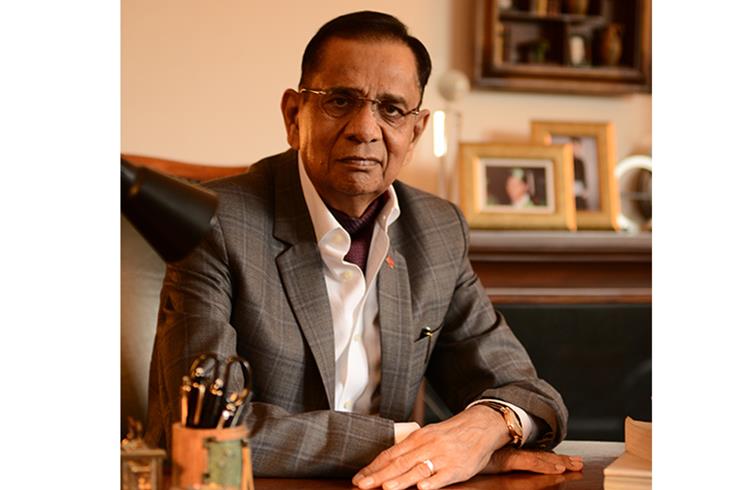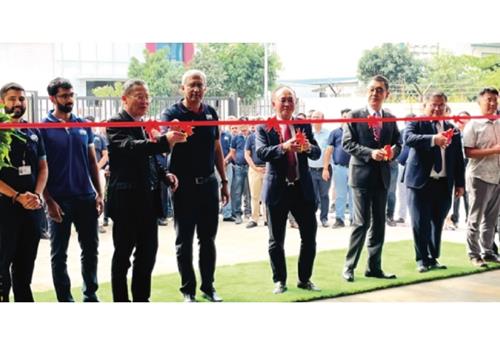India at 75: 'I think India has lost a lot of time’
DK Jain, Chairman Emeritus of Lumax Industries, goes down memory lane in a freewheeling conversation. He believes that India may have lost valuable time by not going in for liberalisation sooner.
It is an overcast Thursday afternoon in Gurugram but the mood livens up when DK Jain enters the Lumax corporate office.
The Chairman Emeritus who has been part of this auto component maker’s growth story for over six decades now is in a mood to go down memory lane and recall his early days as an entrepreneur. “It started off with building relationships and that has been our core strength for the last 75 years,” he says.
This, continues Jain, was the fundamental principle in building the base for Lumax while constantly nurturing it to be able to reach the levels attained today. “My objective was to build more relationships, be it with our employees, customers, or whoever came in touch with us.”
“We were not industrialists, or belonged to a rich family,” continues Jain. “In 1954-55, my father started a workshop that made glasses, and later put up a small factory in old Delhi.” Barely 19 and transitioning from school to college at that time, he was summoned by his father and company’s founder SC Jain, to help him manage the business.
“Within six months, I actually started enjoying working in the factory,” he adds. The company had just received bulk orders to supply roof lamps for the transport authority buses, and later struck up strong ties with the likes of Royal Enfield, Standard Motors and Escorts.
Licence Raj
Jain recalls some of the challenges faced during this era of the License Raj. For instance, when he had to visit Japan for the first time in 1966 to get trained in metallising — a process that is conducted on the plastic headlight reflectors — it took a good four months just to get the foreign exchange for the travel.
Additionally, importing tools and equipment was another ordeal as there were bureaucratic hurdles to contend with and the small-scale industry had to go through stringent procedures. All this did not deter the young man who was determined to take the growth story forward.
“We continuously went on growing right up to 1981. What began as a proprietorship evolved into a partnership when I turned 18, and over time, we became a private limited company,” says Jain. In 1982-83, the company went public and “I committed to myself that to honour the confidence shown by the shareholders, Lumax must be run professionally”.
Aftermarket focus
By this time, the Indian automotive industry was in the midst of massive change with new vehicle manufacturers entering the market. Lumax, which was primarily supplying to the aftermarket, consciously took a decision to switch focus to the OEM side of the business. The idea was to build better relationships and get in touch with “erudite and cultured people”.
The first breakaway from the License Raj began in the early 1980s when Nissan, Mazda, Mitsubishi and Toyota entered the light commercial vehicle space. The two-wheeler arena saw Suzuki, Honda, Kawasaki and Yamaha throw their hats into the ring. This was an inflection point for Lumax when it began to scout for a Japanese partner.
“This is when we got in touch with Stanley Electric Company, one of the leaders in automotive lighting. While reluctant to come to India, it agreed to get into a technical licensing agreement with us in 1983 on Honda’s persuasion,” continues Jain. This was also the beginning of the Hero Honda story in 1984 which would emerge India’s top two-wheeler entity by 2001.
“That was the turning point for us because despite being in the industry for so long, we had no collaborations and were functioning only on reverse engineering,” he adds. The association with Stanley also coincided with the entry of Maruti Udyog which, like Hero Honda, would climb its way to the Numero Uno slot in cars.
Political connections
“At that time, Maruti had no resources other than some 12-15 joint ventures. People were awarded contracts along with a Japanese collaborator to supply components for the Maruti 800 based on their political connections,” says Jain. Lumax, however, held its own thanks to its tenacious chief and its USP was the cost-competitiveness of its products and experience in the industry.
“We were fortunate that despite not having a Japanese collaborator, we were able to get good business from Maruti. We supplied them rearview mirrors, oil-bath air cleaners, wheel caps and a range of other products,” recalls Jain.
The later years in the Maruti association had their share of interesting anecdotes. “I still remember the day when Maruti was gearing up for the Zen launch in 1993 and discussions were on to give the complete lighting system to us or a competitor,” he says.
Stanley, for the first time, had asked for Rs 10 crore in tooling investments and it was RC Bhargava, the Maruti Udyog chairman, who convinced Jain “not to shy away” from paying for the technology. This was a turning point in the history of Lumax where it had imported the entire assembly equipment and fixtures for the Zen’s exterior lighting system from Japan.
“It was very painful for us to pay that sort of money but Stanley was really happy to receive such a big order. What we acquired in the process was knowledge and access to good technology which we leveraged for other OEMs as well. There was really no looking back from that point,” he reminiscences.
Trust and confidence have played a big role in the Lumax-Stanley partnership that has strengthened in the last 40 years. Jain says it is one of the rare Indo-Japanese alliances in the Indian automotive industry where the management control still lies with the Indian side. Today, his sons, Deepak and Anmol, are steering Lumax ahead.
Entrepreneurial spirit
Jain is optimistic about the country’s future especially with the entrepreneurial spirit now more than apparent in young India. “We are seeing many startups coming up across the business landscape with entrepreneurs expanding their ventures. The opportunities are much better today and I hope and believe they will multiply,” he says.
Yet, there is a tinge of regret that even after 75 years of independence, India has not achieved its true potential. “If liberalisation had taken place a bit earlier, India would have perhaps been at a different level altogether. I think we have lost a lot of time and whatever speed we have is still not enough to catch up with the world,” rues Jain.
The good news is the country’s renewed focus on infrastructure, especially roads and highways. “It should have happened long ago and would have given the automotive industry a huge push. India will grow with new solutions and innovations,” he says.
The Lumax patriarch believes the auto industry will continue to see disruptions in the coming years. “World over, the sector is in a state of transformation – changes that call for new products and technologies. We are a great industry that will continue to grow. Little hiccups may come here and there, but if one navigates correctly, any challenge can be overcome,” continues Jain.
Even though it has a comfortable 60 percent market share in the automotive lighting business, the company is bracing itself for future challenges in the automotive industry. Under its Lumax Auto Technologies vertical, it is diversifying into telematics solutions and oxygen sensors while building a significant presence in gear-shift selectors and levers.
“We want to continue our leadership in products required by our customers. If lighting used to be 80-90 percent of our turnover seven years ago, it is now down to 50-55 percent since we have diversified into other areas,” explains Jain.
With electric vehicles now gaining traction, lighting continues to be a relevant business but Lumax is keen on adding more components to its portfolio to grab new opportunities. In January this year, the company commissioned a new electronics PCB assembly plant in Bawal, Haryana, to improve the localisation content of its lighting and electronics products to 70 percent. The Rs 100 crore facility caters to the company’s growing product line that is increasingly seeing the use of more semiconductors.
RELATED ARTICLES
BRANDED CONTENT: Serving India’s EV ecosystem
Shimnit Integrated Solutions Pvt. Ltd. (SISPL), a subsidiary of Mumbai's leading high-security number plate supplier, Sh...
Driving EV business with agility and flexibility
CEOs from the EV startup ecosystem met in Bengaluru and Pune to discuss the challenges and business opportunities.
BRANDED CONTENT: SM Auto and Gotech energy inaugurate their first battery pack assembly plant in Pune
Pune-based SM Auto Engineering (SMA), a leading automotive component system manufacturer and its partner Gotech Energy (...





 15 Aug 2022
15 Aug 2022
 12223 Views
12223 Views





 Autocar Pro News Desk
Autocar Pro News Desk




